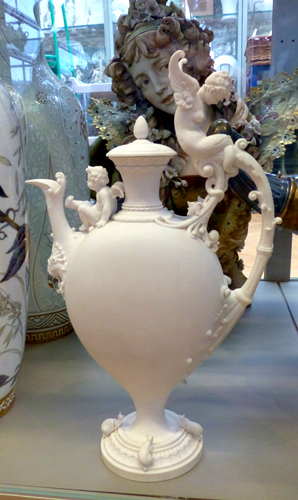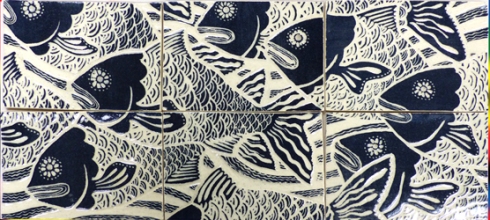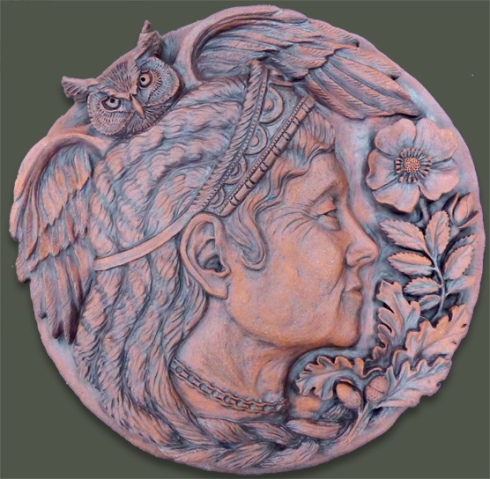BELATED UPDATE!
I never did add the final project images from 2018, so here they are.
Each of these based on an historical concept brought up to date. Knotted Chinese teapots, European and English cabbage teapots and Sevre narrative teapots. Obviously very different in form and indicative of my skills at this point in my ceramic journey. I’m posting these now as I’m hoping to start over with ceramics and have cleared a space in my house to make this possible.
A YEAR OF CREATIVITY
This week I sorted out the studio I’ve been renting at the national Glass Centre. I finish my time in the studio at the end of March, and so everything has to be out of there by that time. I put most of the work I’ve created in the past 18 months on my large table and took a few photographs. here they are:
ARTM66 presentation
A summation of the previous blog entries as a pdf presentation. A few pages have been deleted to reduce the file size.
Results
Over the past few months I have constructed 4 teapots, two have been glazed and two have not.
Coil Built: The first teapot was created in response to a teapot workshop we did with instructor Rob Winter. He asked us first to draw spontaneously with brush and ink a teapot and then from this drawing to create a teapot. I used crank clay and it was coil built. After much deliberation I tried the VC AA Green glaze, fired to 1290ºC. I could have used a thicker application I think.
The second teapot was also coil built and made of terracotta. It is the same size as the first one. This was my first attempt at majolica painting. I love the gloss of the tin oxide glaze, but not so happy with the actual colours. Both these teapots, which are my first attempts, include strainer holes rather than one big hole into the spout. I did my best to keep them clear of glaze, but was not very successful. Other teapots just have a nice large hole into the spout.
Spherical teapots: I chose to continue the teapot project by basing them on the same sized sphere. The first one is made in porcelain covered with oak leaves and acorns on the body and the phrase “the oak sleeps in the acorn”. This is made for my cousin Nell and partner Malcolm. At this point it has been bisque fired to 1060ºC and is awaiting a glaze. My first test is the Antoinette Badenhorst high gloss glaze. Further tests will explore a softer satin surface.
The second teapot is an experiment in terracotta. This has been bisque fired to 1000ºC. I am very happy with the glaze tests and expect to make more ceramics bearing in mind this surface. The glaze is the Stephen Murfitt majolica glaze fired to 1100ºC.
Spring 2018 – Ma Ceramics Module 2
Over the Christmas break, while struggling to recover from a nasty flu, I sent out this list of questions to my 11 first cousins:
1. If I were to make a mug for you what size, colours, designs etc would you prefer?
2. If I were to make a cup and saucer for you what size, colours, designs etc would you prefer?
3. If I were to make a teapot for you what size, colours, designs etc would you prefer?
4. If I were to make a teapot for your parents, what would be the highlights of their life or feelings that it could express?
The purpose of these questions was to find a point of departure for creating functional but personalized objects and to assist me to find a creative direction. The response was informal and corresponded for the most part with what I anticipated. It was a start that I very much needed to help me focus at a time when I had no clear direction.
A brief workshop on making teapots with ceramic tutor Robert Winter kick started the adventure and for the most part this second module has been an exploration of teapots. The majority of my work in the past few years has been self expressive, creating sculpture that begins with a notion and arrives at a form not entirely anticipated. Creating teapots requires planning at all stages and the development of new skills. The teapots are hand built at this point and very much experiments. Glazing will have to be addressed and tested. Spouts will have to pour properly and lids not fall off.
Influences
Books
3 books have been particularly useful in this project: The Artful Teapot by Garth Clark, features artistic and functional teapots from the collection of Sonny and Gloria Comm; Novelty Teapots by Edward Brahmah which features an historical overview of novelty teapots; The Teapot Book by Steve Woodhead which proves to be an excellent source of information on constructing teapots and the contemporary ceramicists who make them.
Conferences
Other important influences have been two conferences I’ve recently attended. The York Centre for the Ceramic Arts held its first 2 day conference entitle Restating Clay. Unfortunately I could only attend day one, but it was worth the journey to the keynote speaker Garth Clark, and to listen to the other speakers. In particular I enjoyed the talk given by Sara Radstone about her work in the main ceramic area of the York Art Gallery. The second was a 3 day conference entitled Ceramic Art London at Central St Martins, London. The keynote speaker was Grayson Perry, and the other talks I attended were given by Emma Lacey (Stage 2 leader, BA Ceramic Design, Central St Martins), Natasha Daintry (describing her commission for Chatsworth), Keith Harrison (explaining his latest work), Phoebe Cummings (reflecting on her floral contemporary sculptures), Ian McIntrye (reinventing the Brown Betty teapot), Matthew Raw (talking about tile design in conjunction with Assemble), and finally Keith Brymer-Jones (describing his journey as a potter). There was also an exhibition of 90 ceramicists who were of the highest quality and diversity and willing to share tips. A great experience.
Exhibitions and Collections
Before leaving London I spent a day in the Victoria and Albert Ceramics collection, noting items that I might ask to study in their study room. One piece in particular caught my eye. Made in Paris in 1884, designed by Albert-Ernest Carrier-Belleuse, sculpted by Auguste Rodin and made of biscuit porcelain. So much to see and think about!

Over the Easter break I visited my cousin Nell and partner Malcolm in Norfolk. Straight off the train we, plus my uncle Tony, went to the Sainsbury Centre (University of East Anglia) to see the Roger Law exhibition. Roger Law is well known for his satirical and brilliant caricatures featured in the Spitting Images series, but perhaps less well known for his ceramics – https://rogerlawceramics.com/. The exhibition was divided into 2 parts – his earlier drawings and models, and the ceramics and prints associated with them. His interest in print and ceramics flourished after he and his wife relocated to Australia. He now makes very large ceramic vessels in China. Here are just a few of the images from that exhibition.
We also visited the Fitzwilliam Museum in Cambridge to see the Things of Beauty Growing: British Studio Pottery exhibition created in collaboration between the museum and Yale Center for British Arts in the USA. This comprehensive overview of British studio pottery was curated under the categories Moon Jar, Vase, Bowl, Charger, Set, vessel, Pot and Monument and featured works by many well known past and living ceramicists. The accompanying book, which is a series of essays and includes a comprehensive exhibition catalogue, was well worth buying for its content and imagery. Unfortunately no photography was permitted.
Fall 2017 – Ma Ceramics Module 1
After a summer of travel and packing up my house and studio and handing it over to my longtime friend Jonathan I arrived in Sunderland to start the MA in Glass and Ceramics. It was not an easy start. A new city, living in residencies, being back in the UK to live and a whole host of things to get used to.
Module 1 of the program was about experimenting and testing, and being short of any ideas about what I wanted to focus on I tried everything. At the end of the module we were assessed and this is the review I created to sum up my activities: artm69-assessment1
My main experimentation was in glass. However, it became apparent that this was not a medium I felt was in keeping with my creative preferences and at the beginning of Module 2 I began to focus on ceramics again.
Spring 2017 – Commissions, travel and decisions
In the beginning of 2017 I completed a commission for friend Rick. He requested a tiled image to go in his kitchen above the sink. I chose to experiment with tile making in general and so inspired yet again by my pond, I created 6 square lino-cuts and mounted them on wooden blocks. The design was created to repeat with a half drop of the total image. The 6 tiles can be read as a continuous strip, a separate image, or as a wall of tiles. The original design was created with the aid of Adobe Illustrator in order to align the connecting tiles, but drawn in black ink. With the aid of an ancient book press each tile was pressed. I also designed a repeating border. These photographs show the variations tested.
As the spring progressed I felt the need to go on a ceramic adventure in order to discover how serious I was/am about working with clay. I applied and was accepted into the MA Glass and Ceramics program at the National Glass Centre, University of Sunderland, UK. This is my application portfolio: 2017 Application Portfolio – Janis Iris Churcher
Other activities at this time ceramics included further explorations in shallow relief. The translation of a coloured pencil illustration and a portrait of my mother with an unusually anxious expression.
Fall 2016 – Directed studies 3
After a visit to family and friends in the UK and a walk through beech woods and beside massive oak trees, I spent the next few months trying to capture the connections between trees. Their roots and branches intertwining. The form and leaf canopies evolved as the sculptures developed. The beech trees are created in terracotta and the oak trees in M370. Both are washed in a manganese glaze and fired to cone 6.
Spring 2016 – Directed studies 2
At the beginning of this semester I completed what I would call a modernist sculpture, created entirely because an excess of creative energy needed expression. The theme of self expression continued and 3 sculptures expressing the architecture of feeling, thought and contemplation emerged. The hint of other cultures is apparent. All these sculptures are made of Navaho Wheel grogged and naked fired to cone 6. They are between 17 ins and 22 ins high.
Fall 2015 – Directed studies 1
For the directed studies class I continued to develop vessels inspired by the Jomon culture. They are all made of terracotta and fired to cone 6.
Spring 2015 – The wheel
The spring semester was given over to learning to throw vessels on the wheel. We began with cylinders, then progressed to 6 identical bowls. Then 6 identical mugs.
The major challenge was to create 4 sectional vases inspired by early mediterranean vessels. Here they are:
We were also asked to create a short presentation on a historical aspect of ceramics. I chose the Japanese Jomon culture. In order to understand their very unique pots I attempted to recreate one using photographic evidence. It was a fascinating and educational experience and proved to be a starting point for later personal work.
Christmas Break 2014
Over the Christmas break I took home some clay and experimented with pinch pots and under-glazes. Here are a few examples. The fish plate glaze was not particularly successful, but the small pinch pots are quite pleasing once glazed. I don’t appear to have any photos of these.
It is thought that the properties of fired clay were discovered when baskets lined with waterproofing clay vitrified when exposed to heat. This modern basket was lined with Navaho Wheel terracotta and fired to cone 6. But not before I tried a firing in the woodstove. Now I have my own pottery fragments!
Fall 2014 – 4th project
To create a set of 6 sgraffito designed tiles. I chose to create one design over the 6 tiles based on fish. Each tile is approximately 5ins x 3ins. The sgraffito technique involves creating the clay slab, coating with an under-glaze or wash at the leather hard stage, and scraping away the design to reveal the clay surface.

Fall 2014 – 3rd project
To create a set of hand built mugs applying a decoration created an using easy-cut lino design. I also made a first attempt at a slab built teapot. We also created a few items that were raku fired. As you can see we needed to be fully protected according to the university’s health and safety rules.
Fall 2014 – 2nd project
The objective was to create a 16 inch self portrait in shallow relief based on Roman coins. It was also to express some aspect of our personal aspirations. I chose the Owl for wisdom, the Rose for love and the Oak for strength. The clay was Navaho Wheel with a black wash applied and wiped off in places and fired to cone 6 .
Fall 2014 – 1st project
Scott gave us this challenge – to create a life-sized self portrait. We first created an armature of a ball of newspaper taped to a thick wooden dowel. The portrait was then built around this and when complete the top of the head was removed and I chose to leave my head as a vase.

























































































































